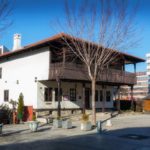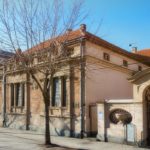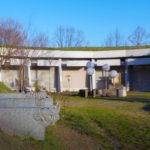HISTORY Welcome to NATIONAL MUSEUM KRUŠEVAC
It collects, preserves, protects and exposes movable cultural goods and remains of material culture of homeland.

By the Law on the Organization of Gymnasiums in the Principality of Serbia, a lower gymnasium was established in Kruševac.

The school was officially opened, and its neo-Renaissance architecture was a reflection of the ruling style of the time in the construction of educational buildings.

The symmetrical composition was achieved with the expansion of the building, while the facades were enriched with secessionist decorations, as well as the reliefs of Vuk Stefanović Karadžić and Dositej Obradović above the main entrance.

The gymnasium has been moved to a new building, while elementary school continues in this area building, interrupting classes only during the war when the German army was housed in it.

The city plan envisages that the remains of medieval Kruševac be presented and set in order, and the building of the former gymnasium was selected for the accommodation of the newly founded museum.

During the adaptation, the architect Mirko Kovačević respects the authenticity of the building without disturbing the general impression of the whole and preserving certain details, such as the appearance of the entrance hall and the ceremonial hall on the first floor.

As a part of the spacious whole of the city of Kruševac, the museum building enjoys the status of a protected cultural asset.
+
visitors per year
sets of exhibitions
years behind us
+
collected artifacts
KRUŠEVAC FORTRESS – Medieval fortress of Lazar Hrebeljanović
The Ottomans’ advancing from the south had caused that the focus of the Serbian medieval state move towards the northern, border areas of the former empire, towards the basin of three rivers of Morava. The establishment period of the medieval Kruševac, the throne town of the Prince Lazar Hrebeljanović, should be quested after the battle on the Marica (1371), presumptively between 1374 and 1376/77, more precisely between the final victory over the greatest internal enemy, the master of Rudnik region Nikola Altomanović, and the first mention of the town name in the Bologna transcript of the Charter of Ravanica. In the charter, from January 9th 1387, with which the Prince confirmed the privileges to the citizens of Dubrovnik, the town was mentioned as his seat with the words: “in the famous town of my dominion, Kruševac”.
Using a natural plateau, the Prince fortified the town with ramparts within which he built a palace and about thirty buildings yet. In the middle of the fortress he erected a court church Lazarica. According to Constantine the Philosopher, the temple was dedicated to the archdeacon Stefan, the saint patron of the Nemanjić dynasty, and in the glory of the Prince’s firstborn son. The church is of the form of trefoil, with cube, and richly decorated with rosettes and Moravian ornamentation, carved in stone. The throne town of the Prince Lazar and his son, the heir, Despot Stefan Lazarević (1377–1427), enjoyed a great reputation and significance, not only as a centre of the Moravian Serbia, but also as a political focus of the Serbian states of the time, what remained until 1408, when Despot moved the throne town to Belgrade.
After the Battle of Kosovo, at the end of XIV century and particularly in the first half of XV century, Kruševac, being the significant strategic place, was often targeted for the attack. After several successive destructions, it finally fell under the Ottoman rule (1455), which, with shorter ceases, lasted until 1833.
The Institute for the Protection of Cultural Monuments of Serbia and the Institute of Archaeology Belgrade conducted extensive archaeological researches of Kruševac Fortress complex (1961–71). The urban plan provides that the area and the remains of the medieval fortress are presented and arranged as a unique park complex, within which – besides the church Lazarica and Museum central building – stand the sporadic remains of the town ramparts with donjon, as well as the remains of the Prince’s palace and the supporting buildings. The whole complex, as a spatial entity, enjoys protection as the cultural monument of the outstanding importance (RS Official Gazette, No 14/79).
Check out Our COLLECTIONS
- Natural collection
- Archaeological collection
- Historical collection
- Ethnographical collection
- Cultural history collection
- Applied arts collection
- Fine arts collection
Call us
Address
National museum KRUŠEVAC, Trg despota Stefana 15, 37000 Kruševac, Serbia





